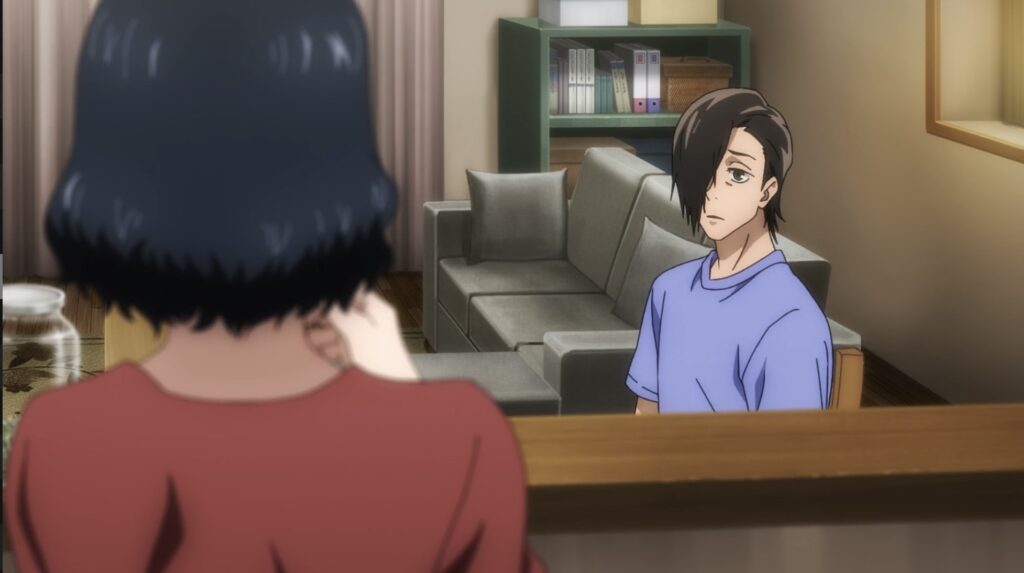By Marcos Villa Marin
Throughout this publication I will be answering, What are the differences and similarities between Traditional and Modern Japanese Architecture?

To give a little background of the two series, Jujutsu Kaisen is about a high school student named Yuji Itadori who gets involved in the world of Jujutsu Sorcery. He battles cursed spirits and uncovers dark secrets along with his friends who also are Jujutsu Sorcerers. The anime is set in the year of 2018.
Demon Slayer is about two members of a family survived from an attack by demons. Tanjiro and his sister Nezuko, who is slowly turning into a demon, sets to avenge their family and find a cure for Nezuko. Demon Slayer is set during the Japanese Taishō Period. The period is distinguishable by the mixture between traditionalism and modernism.

Demon Slayer, the anime, does a fantastic job of showcasing traditional Japanese architecture. Throughout the show, you’ll notice the beautiful and intricate details of traditional Japanese houses, temples, and even the demon slayer headquarters. This building features sliding doors called “fusuma” and “shoji,” tatami mat flooring also elements like “engawa” (verandas). The Materials that were use are clay roof tiles, paper and wood. Details I have noticed are that the design involves the use of symmetry as you can see from the doors. The elevation is another detail which helps “to prevent moisture from the ground getting into the house” so “the floor is elevated several tens of centimeters (around 18 inches) and is laid across horizontal wooden floor beams”. The amount of space that isn’t occupied by furniture or things is something I noticed and it relates to the belief in Buddhism that, less is more and to remain humble. The last thing I want to mention is the use of natural elements like trees and rocks which correlates to the idea of respecting nature by using natural elements to create a beautiful scenery.

Jujustu Kaisen, another awesome anime, showcases modern Japanese architecture in a captivating way. In the show, you’ll see modern buildings, schools, and urban landscapes that reflect the contemporary architectural style of Japan. Jujutsu Kaisen captures the essence of modern Japanese architecture by featuring sleek and futuristic designs. The anime often depicts high-rise buildings, bustling city streets, and modern interiors that incorporate elements like large windows, open spaces, and minimalist aesthetics. It creates a visually striking contrast to the supernatural world within the anime. One notable example is the Tokyo Metropolitan Jujutsu Technical High School, where most of the story takes place. The school’s architecture is representative of modern Japanese design, with its clean lines, glass facades, and spacious classrooms. It creates a visually striking contrast to the supernatural world within the anime. Junpei’ s Neighborhood you can see that most of the buildings are made from reinforced concrete, use of natural elements like trees and few use glass doors. Another identifying detail is the simplistic designs of the buildings.

The similarities between the two styles of Japanese Architecture on an exterior level is the use of natural elements in surrounding landscape of the building like trees and rocks. I believe that the idea of respecting nature is still being incorporated because it gives a nice aesthetic and so that it doesn’t look so fabricated. The simplicity is another similarity in both styles which I think it tides back to the belief that simplicity helps people to focus less on materialistic things and appreciate life and the beauty of nature. Symmetry is also use as you can see from the previous examples the lines help create an intricate and simple design.

These two pictures captures the essence of traditional Japanese interior by featuring elements such as sliding doors, tatami mat flooring, and the distinct wall styles seen in traditional buildings. The use of wooden structures, paper screens, and the incorporation of nature into the design are also prominent in these examples. From these examples you can also see the amount of space there is given that there are furniture. Both of these rooms have a Tokonoma (Alcove), the use of this is to display paintings, pottery, flower arrangements and other forms of art. Connecting back to the belief of appreciating life and nature this feature is for the reasoning for that. In Buddhism its a common thing to have a space where the home owners can admire something or do relaxing activities so from the examples you can see Tanjiro removing leaves from a plant and in the other displaying art.

In this modern home you can see a significant difference between the interior design of a Modern and Traditional Japanese style home. The material of the walls are concrete and you can see the use of wood to outline the window frame and the half wall. The wall doesn’t include any design but that simplicity I feel like a is a trade of to incorape furniture. The inside looks more compacted since the furniture is using a lot of the inside space and I came back to the realization of what “less is more” really meant. Although the floral rugs, couch, and bookshelf does occupy a lot of space, it helps with making a place look great and feel comfortable.

Entertainment Facility & Junpei Yoshino‘s House
The similarities I see in both is the simplicity but it’s incorporated differently in both. In traditional the simplicity comes from the little usage of the space as for modern simplicity is still incorporated on how the walls are. Another thing is that the rooms serves a purpose thats important. The use of wood and symmetry still remain the same in modern architecture.
Japan-ness
“Japan-ness” is a term used to describe the unique cultural identity and characteristics that are associated with Japan and its people. It encompasses various aspects, including traditional and modern Japanese architecture, art, cuisine, customs, and more. When we talk about how anime like Demon Slayer and Jujustu Kaisen showcase traditional and modern Japanese architecture, it’s a way of exploring and celebrating a part of Japan-ness. These anime not only entertain us with their captivating stories but also provide a glimpse into the rich cultural heritage and contemporary urban landscape of Japan. By featuring traditional and modern architectural elements, these anime help to create a sense of authenticity and immersion in the Japanese setting. These incorporated features also relates back to the morals and beliefs that Japanese people believe in, such as Shintoism and Buddhism. Japan-ness and Shintoism are closely intertwined. Shintoism is an indigenous religion in Japan that has greatly influenced the cultural identity and practices of the Japanese people. It is deeply rooted in the concept of Japan-ness. Shintoism encompasses a belief in the existence of kami, which are divine spirits or forces that are present in nature and various aspects of life. These kami are believed to be the guardians and protectors of Japan. Shinto rituals and practices are performed to honor and connect with these kami. So the use of natural elements like rocks and trees not only helps to appreciate the beauty of nature but a sense of spiritual protection. Buddhism also similar to both ideas talks about that is good to have less and use or have things that are meaningful. All of this contributes to the overall cultural representation and appreciation of Japan-ness in the world of entertainment.